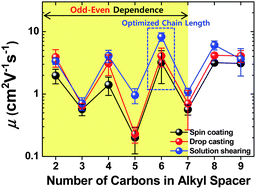Effect of the alkyl spacer length on the electrical performance of diketopyrrolopyrrole-thiophene vinylene thiophene polymer semiconductors†
Abstract
For systematic investigation of the structure–property relationship, a series of diketopyrrolopyrrole-thiophene vinylene thiophene (DPP-TVT) polymers, ranging from 25-DPP-TVT to 32-DPP-TVT, with branched alkyl groups containing linear spacer groups from C2 to C9, has been synthesized. The electrical performance of these polymers is clearly dependent on the length of the spacer group and shows the odd–even alterations in chemical and electronic properties induced by the different alkyl chain spacers. Spacer groups with even numbers of carbon atoms exhibit higher charge-carrier mobilities than those with odd numbers of carbon atoms for the linear spacer groups from C2 to C7. Furthermore, the optimal side chain geometry in the DPP-TVT system for the most efficient charge transport contains the C6 spacer between the branching point and the backbone, showing the maximum hole mobility of 8.74 cm2 V−1 s−1 (at VGS, VDS = −100 V). The results obtained herein demonstrate the intriguing odd–even effects induced by the length of the side chain alkyl spacers for DPP-TVT polymers, and provide insight into the side chain engineering for the most efficient charge transport in DPP-based polymer semiconductors.


 Please wait while we load your content...
Please wait while we load your content...